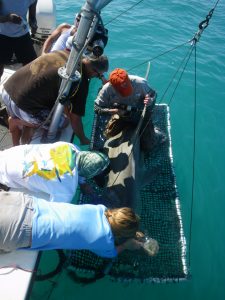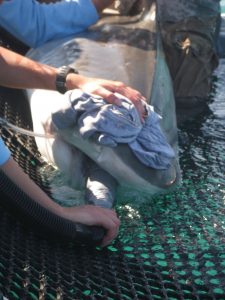Day two- Gulf Coast Shark Trip in Lee County
May 26th, 2010
We normally do our shark research in the Florida Keys, however, as Dominique mentioned, we got the opportunity to start doing research in the Gulf of Mexico in collaboration with Florida Gulf Coast University and the West Coast Inland Navigational District. On our way over to the Vester Field Station we all took guesses on what we would catch. Most of us said Bull Sharks, some Lemon Sharks and a few Nurse Shark, since we know these species are quite prevalent over there. Well, we were in for quite a surprise. As you may have read on Tuesday we caught 2 Tiger Sharks and a Great Hammerhead shark. We put satellite tags on all these animals. Catching a Hammerhead is quite a treat because they are very rare and elusive animals, but catching a tiger shark? This was to good to be true, wow! Everyone involved couldn’t believe it could get any better! The film crew Mark Rackley and Christian Gatti had captured everything with their ingenious techniques and our satellite tags were deployed in record time.

A Great Hammerhead getting her satellite tag, the shark team working hard to release her quickly. Great Job! (click to enlarge).
After coming back to the dock on Tuesday we had all planned to take a shower and then actually head back out to do research at night, however, the storms were coming and we had to stay in. As a group we decided to make the best of our bait and our time and catch as many sharks as possible the next day, so we got up at 5:00 am on Wednesday to head out for what turned out to be a 7.5 hour long shark fishing day! We were sun burnt and dehydrated and it was really hot, but we didn’t care. Why? We caught 3 more Tiger Sharks and another massive Great Hammerhead! It was the most amazing experience of my life. I have a big tiger shark tattoo on my back and can you believe I had never really gotten an up close and personal view of this beautiful animal? Well I did, we all did and it was all caught on film. We also caught some of the largest Blacktip sharks I have ever seen and they were super frisky, as Dom will admit too. She was almost flung over board.
In just two days we tagged and sampled 14 sharks (5 x tigers, 1 x blacknose, 3 x blacktips, 3 x nurse sharks, and 2 x great hammerhead sharks)!

Sweet Caroline is getting her satellite tag! We have a pump is her mouth and a towel over her head to maximize comfort out of the water. (click to enlarge)
Being apart of this tagging program is an amazing experience. As an avid shark conservationist I have done a lot of shark awareness presentations to dive clubs, colleges, children etc. For a while, you feel as though you only talk about saving these sharks, how endangered they are, and how vital they are to the ecosystem, but rarely do you get to combine educational awareness with research. Not only can I educate the public on the plight of sharks, but I can also see first hand the beauty of these animals and help do research that may save their life.
I would like to take the opportunity to tell you about our tags: Our tags are custom made with the best safety of the shark in mind.
1) Although we mount the tag on the fin, we use special neoprene protectors between the tag and fin so that NO metal or plastic touches the shark fin (this prevents vibrations on the fin and prevents fouling and metal corrosion on the fin).
2) Instead of using plastic rods to secure the tag on the fin (which fouls and also does not disintegrate and never comes off)…we use special very expensive medical grade titanium bolts. This prevents any fin damage, corrosion or fowling. These are the bolts surgeons use in human surgery.
3) The bolts are attached by metal nuts (which do not touch the shark skin) but only the titanium bolts. In the seawater this causes a galvonic charge, causing the nuts to slowly corrode. Thus, the tag will eventually fall off!!
In the meantime, these tags provide real-time GPS info on shark movements. We can attach the tag in less than 4 minutes, with a water pump in shark’s mouth. The sharks can then swim away in great condition. We have taken ever step to minimize harm and promote animal safety. This information is crucial to getting these animals on the protected species list.
Needless to say, it was the most amazing trip and I will never forget it. Thanks to Dr. Neil Hammerschlag for allowing this program to exist, thank you to Captain Curt for so many things, especially your patience, and thank you to Dominquie Lazarre for running this program with lighting speed.

Putting our pump in the shark’s mouth so she can breath. The sling that this blacktip is on allows us to work up the shark faster. (click to enlarge).
Thank you to all involved and our collaborative project partners. We look forward to future trips and we would like to thank our project collaborators and partners:
Ray Judah, Lee County Comissioner; Bob Wasno, Vester Field Station Education and Resource Coordinator,Florida Gulf Coast University; Darren Rumbold, Associate Professor, Florida Gulf Coast University; Charles W. Listowski, Executive Director, West Coast Inland Navigational District; and Aswani Volety, Chair of Marine & Ecological Sciences and Professor of Marine Science, Florida Gulf Coast University.
Stay tuned for more amazing adventures with the RJ Dunlap Marine Conservation Program!
Cheers,
Brendal Davis (Shark Intern)
P.S. Don’t forget you can track our sharks live! Please go to http://www.sharkresearch.rsmas.miami.edu/learning-tools/ and follow their adventure.




Leave a Reply
Want to join the discussion?Feel free to contribute!